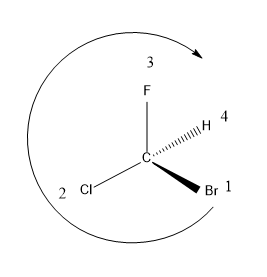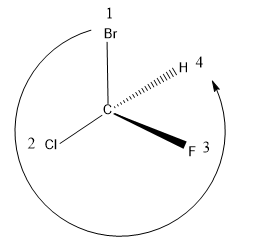
Explain R.S. nomenclature with illustrations.
Answer
553.2k+ views
Hint:The R and S nomenclature is helpful for the identification of the arrangements of groups on the enantiomers around the chiral centre.
R refers to rectus which means right in Latin and S refers to Sinister which means left in Latin.
Complete answer:
We know that for an optically active molecule there will be a chiral centre or chiral carbon.
Chiral carbon is the carbon atom in which the four groups attached to them will be entirely different groups.
R and S configuration is very much helpful for us to identify the enantiomers.
In R and S nomenclature, we assign a number, according to the CIP rules for each group of atoms or atoms that is attached with the chiral carbon.
CIP rules means Cahn-Ingold-Prelog prioritizing rules and the substituents present in the molecule is assigned according to this rule. According to CIP rule, the substituent with the highest atomic number will be assigned as 1 and next as 2 and then 3 and the last one will be 4.
So in short we can say that, the CIP rule for prioritizing substituents is according to the atomic number of the atom.
And we will find whether the enantiomer is having R is S configuration, in such a way that, after assigning the groups if the arrangement of the substituents is in clockwise direction then the molecule possess the R configuration and if the substituents are arranged in anti-clockwise fashion then the molecule is having the S configuration.
For more clarity let’s consider an example,

In this structure, Br is the substituent with highest atomic number hence it is assigned as the first group then Cl, F and H.
H is the lowest priority group (LGP) and the bond between H and the chiral C is represented in dash representation i.e. the bond is away from the observer. The LGP should always be present away from the observer.
After assigning the groups, let’s trace the direction of arrangement of the substituents from the highest priority group to lowest priority group.
As we have traced the direction in the figure, the arrangement of substituents is in the clockwise direction. Hence we could say that the molecule is having R configuration.
Now let’s see if the structure was having S configuration, then what will be the arrangement of the substituents.

Here the same molecule is represented, but here the substituents are arranged in space in different fashion.
After assigning the groups, if we trace the direction of the substituents, the direction of HGP to LGP is in the anti-clockwise direction i.e. in S configuration.
Note:
If the lowest priority group is not present in the dash bond position of the molecule i.e. in the position away from the observer, then we have to carry out rotation so that the groups are interchanged and the LGP gets the dashed position. Then only the numbers should be assigned and the configuration should be determined.
R refers to rectus which means right in Latin and S refers to Sinister which means left in Latin.
Complete answer:
We know that for an optically active molecule there will be a chiral centre or chiral carbon.
Chiral carbon is the carbon atom in which the four groups attached to them will be entirely different groups.
R and S configuration is very much helpful for us to identify the enantiomers.
In R and S nomenclature, we assign a number, according to the CIP rules for each group of atoms or atoms that is attached with the chiral carbon.
CIP rules means Cahn-Ingold-Prelog prioritizing rules and the substituents present in the molecule is assigned according to this rule. According to CIP rule, the substituent with the highest atomic number will be assigned as 1 and next as 2 and then 3 and the last one will be 4.
So in short we can say that, the CIP rule for prioritizing substituents is according to the atomic number of the atom.
And we will find whether the enantiomer is having R is S configuration, in such a way that, after assigning the groups if the arrangement of the substituents is in clockwise direction then the molecule possess the R configuration and if the substituents are arranged in anti-clockwise fashion then the molecule is having the S configuration.
For more clarity let’s consider an example,

In this structure, Br is the substituent with highest atomic number hence it is assigned as the first group then Cl, F and H.
H is the lowest priority group (LGP) and the bond between H and the chiral C is represented in dash representation i.e. the bond is away from the observer. The LGP should always be present away from the observer.
After assigning the groups, let’s trace the direction of arrangement of the substituents from the highest priority group to lowest priority group.
As we have traced the direction in the figure, the arrangement of substituents is in the clockwise direction. Hence we could say that the molecule is having R configuration.
Now let’s see if the structure was having S configuration, then what will be the arrangement of the substituents.

Here the same molecule is represented, but here the substituents are arranged in space in different fashion.
After assigning the groups, if we trace the direction of the substituents, the direction of HGP to LGP is in the anti-clockwise direction i.e. in S configuration.
Note:
If the lowest priority group is not present in the dash bond position of the molecule i.e. in the position away from the observer, then we have to carry out rotation so that the groups are interchanged and the LGP gets the dashed position. Then only the numbers should be assigned and the configuration should be determined.
Recently Updated Pages
Why are manures considered better than fertilizers class 11 biology CBSE

Find the coordinates of the midpoint of the line segment class 11 maths CBSE

Distinguish between static friction limiting friction class 11 physics CBSE

The Chairman of the constituent Assembly was A Jawaharlal class 11 social science CBSE

The first National Commission on Labour NCL submitted class 11 social science CBSE

Number of all subshell of n + l 7 is A 4 B 5 C 6 D class 11 chemistry CBSE

Trending doubts
Differentiate between an exothermic and an endothermic class 11 chemistry CBSE

10 examples of friction in our daily life

One Metric ton is equal to kg A 10000 B 1000 C 100 class 11 physics CBSE

Difference Between Prokaryotic Cells and Eukaryotic Cells

1 Quintal is equal to a 110 kg b 10 kg c 100kg d 1000 class 11 physics CBSE

State the laws of reflection of light




